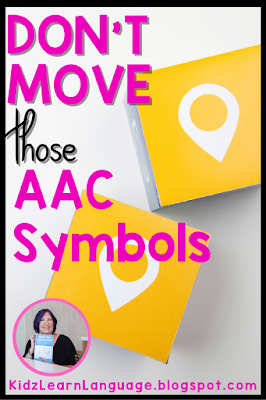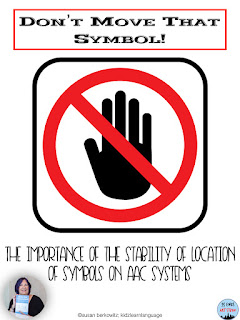In an on-line discussion recently a speech-language pathologist was looking for research that specifically discussed why we do NOT move symbols around on a child’s AAC system. Doing so to “test” children, to make sure they really are discriminating the specific symbols, has nothing to do with communicating; a fact that practitioners of ABA don’t always “get.”
Now, I’ve worked in some very very rigid ABA programs myself, but there are some principles that we followed regardless of such issues.
- Symbols stayed in one place in a communication book (this was in the days before high tech).
- Symbols were used for communicating, not testing. Studies I conducted in one setting actually showed that teaching isolated discriminations may have resulted in the students knowing which symbol meant which word, but that definitely did not lead to using the symbols to communicate once they were placed in the communication book. Modified incidental teaching in context did that.
- Symbols were always available. Students had their communication books with them at all times. Symbols were accessible for communicating at all times. That’s the whole purpose, isn’t it? You wouldn’t take your mouth off and leave it behind, would you?
(Yes, that sounds silly, but really it’s the whole point. Most of us have no idea what it’s like not to be able to speak when you have something to say. I have often challenged administrators to spend a day with duct tape across their mouths and no pencils in their hands.)
PRC systems, which utilize core words and consistent motor patterns to access words says this:
“ In typical speech, our attention is directed to the conversation, not to articulating/saying the words. In order for an AAC user to develop this same “speaking” automaticity, he can’t be consciously thinking about interpreting or locating icons.
For automaticity to develop, each word needs to be accessed by a unique motor plan that once learned, never changes. Two words cannot share the same motor plan.”
One analogy that works for some people is to liken the AAC system display to a typewrite/computer keyboard. As I recall from my 3 weeks in a high school typing class touch typing relies heavily on the motor patterns of hitting specific keys in specific locations. What typist would keep working if you were constantly moving they keys around? I can barely find the letters as it is!
LAMP training tells us:
“Speaking is a motor plan, as are tying shoes and typing. Once the plan is learned it becomes automatic.
o We don’t have to think about how to make a word with our articulators
o We communicate well because we have automaticity
o LAMP helps develop automaticity in a way that other approaches do not.
o If a motor movement changes each time we say a word, we do not develop automaticity. Consistency of that motor pattern is key for teaching language.
o A word can be produced in 1-3 keystrokes along a unique and consistent motor pathway. The AAC user can devote more cognitive energy to interacting vs. navigating through category pages.”
In summary, [AAC users need a] “Unique and Consistent Motor Plan: stable word location leads to effortless communication due to low cognitive load”
On the Assistiveware blog is this: “Augmentative and Alternative Communication (AAC) is blocked when users are required to prove themselves as ready and worthy before they can get AAC. Instead we should be presuming competence and not requiring any prerequisite skills before they can be eligible for a full balanced AAC system.”
Our job is to make communicating as easy and possible. Let’s not use unnecessary demands to make it more difficult.
Keep on talking!





I have had this conversation about ten times this year already. Thanks for writing this!
ReplyDelete